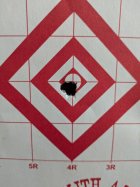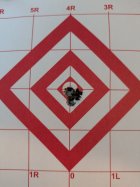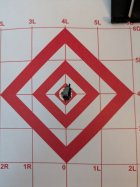To get a rough idea of the powder step it takes to see a 10 fps change.
Here is the typical Hodgdon web site data
View attachment 1616300
If we take the simple approach to scale the equivalent powder change to see roughly what it takes to get a 10 fps difference.
(2694 - 2573)/(41.5 - 38.8) = 44.8 fps per grain, so then 10/44.8 = roughly 0.22 grains
I wondered about the same questions as
@Hengehold
A 10 fps difference isn't much in some ways, and how meaningful it is depends on his point.
If your load tune window is only 10 fps wide and then makes you unhappy, you end up with a real challenge to hold it.
It isn't impossible, but it is difficult to pre load ammo in different sessions, store it, transport it, etc., and still keep the speed exactly. We even have temperature, weather changes, barrel condition, etc., to manage.
If the averages of the first brass were really solid and had a good sample size behind them with a small SD, then we have a decent baseline.
I'm not discounting a 10 fps difference, just that it takes some real solid baseline with a very tight SD to say the different brass batch was really to blame.
Is the 10 fps difference more than an one SD away between the two averages?
Without taking an in depth look at your actual speed data for both batches of brass, you can get a preview of the statistical significance based on the SD. If your 10 fps difference isn't more than 1 SD away on the averages, the two batches are likely in family and the issues are from under-sampling.
If you have solid stats behind your baseline with a tight SD of less than 10 fps, and you have more than 15 samples of speeds from 2X fired brass on the next batch that is different by more than 1 SD, you can run a statistical test to see if those two are really different. (Or we can run that test for you)
Is the powder still producing the exact average speeds between the two brass batches?
If it is, then it would be time to examine the internal capacity of the brass, anneal both, check the condition inside the necks, check the thickness, and then re-test.
We can even get a difference in speed if we allow the powder's water content to change, but we would find that issue by loading them both at the same session and see if the difference still exists.
At the same time, I agree with
@1K6BRA , nothing wrong with the groups in those photos.
Kudos for keeping the pencil sharp and working on good shooting.
Merry Christmas and Happy New Year!!!














